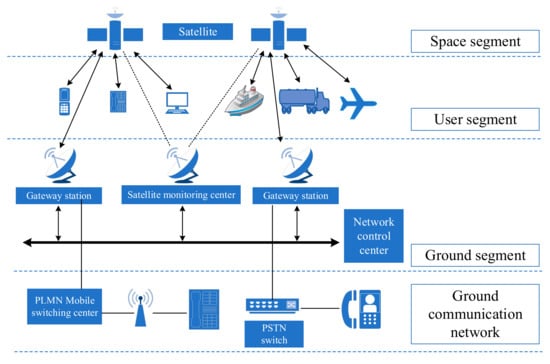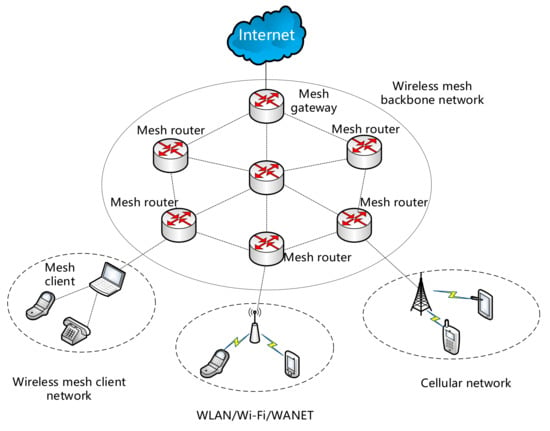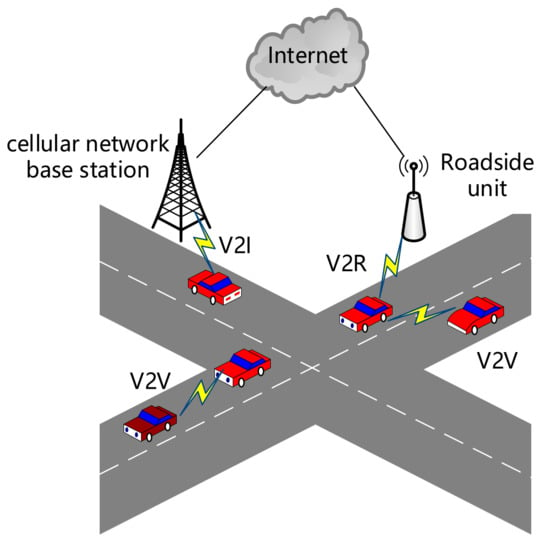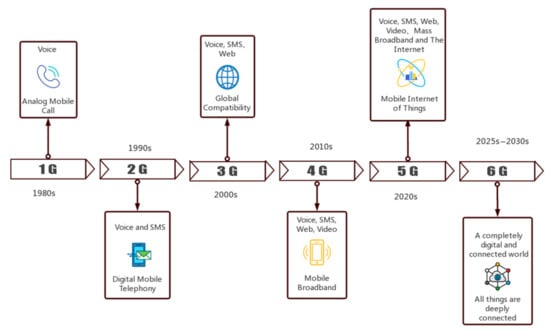Cellular mobile communication adopts cellular wireless networking mode to connect terminals and network devices through wireless channels, so as to realize mutual communication between users. After developing the 1G, 2G, 3G, and 4G technologies, cellular mobile communication technology has entered the 5G era, and the development vision of 6G was proposed at the same time [
87,
88,
89,
90]. The development trend from 1G to 6G is shown in
Figure 7. Modern mobile communication technology can be mainly divided into low frequency, medium frequency, high frequency, VHF, and UHF frequency bands. In these bands, technicians can connect terminal devices in the mobile communication network, using mobile station technology, base station technology, and mobile switching technology to meet people’s mobile communication needs. In emergency communication networks, the most significant advantage of mobile communication technology is the large communication distance, wide coverage area, and low cost. However, in the case of major natural disasters and public safety accidents, the public communication network may be interrupted and unavailable, and seriously affect the rescue effect.
With the advent of MIMO technology and D2D communication, 5G is widely used in disaster management. 5G networks will integrate a variety of promising technologies, such as software-defined networks (SDN), software-defined wireless sensor networks (SD-WSN), coordinated multi-point processing (CoMP), MIMO, network function virtualization (NFV), and centralized radio access networks (CRANs) [
91]. D2D communication in cellular networks supports direct communication between near-end mobile devices without the need for base stations (BSs) and core networks, and can be used to extend network coverage and enable infrastructure free connectivity. Therefore, D2D communication has become an indispensable candidate technology for next-generation wireless networks and an effective alternative to cellular communication during a disaster.
2.4. Wireless Private Networks
In the case of natural disasters and public security and other emergencies, due to the interruption of public communication networks or the inability to use public communication networks because of security reasons, it is often necessary to restore or supplement on-site communication in a short time using private networks. According to the technology used, emergency private wireless networks can be divided into five stages, namely, analogue cluster/conventional, narrowband digital cluster/conventional, 3G cluster, 4G broadband cluster, and 5G evolution. With digital wireless communication technology, digital cluster and conventional digital technology have been developed rapidly. PDT in China, Tetra and Digital Mobile Radio (DMR) in Europe, and P25 technology in the United States represent the narrowband digital cluster. As public network communication is evolving from 4G to 5G, digital cluster private networks are also gradually evolving in the direction of broadband multimedia [
96]. 5G applications in the emergency industry will use 5G and artificial intelligence (AI) as the main approach and vigorously develop related applications.
Wireless private networks, represented by digital trunking wireless communication systems, have the characteristics of high confidentiality, high reliability, and low service cost. They are mainly used in specific fields such as public security, fire protection, rescue services, and the petrochemical industry. Private network mobile communication systems include interphones, non-central digital systems, and trunking communication systems. An interphone is a two-way communication tool that is suitable for real-time communication, emergency dispatching, and collective cooperation. If natural disasters destroy the public network infrastructure, thereby preventing communication, the role of interphones will be more obvious. A trunked mobile system is a special dispatching communication system that is part of the advanced development stage of the private radio dispatching network. The system can dynamically, automatically, quickly, and optimally distribute the limited channels to all users of the system, so as to make maximum use of the channel frequency resources of the whole system. To date, an 800 MHz wireless trunking mobile communication system has been gradually established in various cities in China. Trunked mobile communication networks can be divided into two types: Public Access Mobile Radio (PAMR) networks and Private Mobile Radio (PMR) networks. To date, the commonly used standards in digital private communication include DMR, Digital Private Mobile Radio (DPMR), and PDT. The DMR standard adopts Time Division Multiple Access (TDMA) technology, supports single call, full call, group call, and selective call modes, and also supports direct mode communication without a base station. DPMA is a narrowband (6.25 KHz) Frequency Division Multiple Access (FDMA) technology that can provide various forms of voice/data applications. The PDT standard adopts TDMA multiple access mode and is based on the Chinese public security market. It not only supports low-cost single base station system communication, but can also achieve efficient regional coverage. While satisfying basic business requirements, it also adds innovative functions such as simulcast and dynamic frequency resource management. In earthquakes, wind disasters, fires, and other emergency events, the private communication network can quickly access the rescue dispatching platform, to realize flexible networking, efficient command and dispatching, high-quality voice and data transmission, and other functions.
LTE is a long-term evolution technology based on 3GPP. LTE networking has the following advantages: it has a fast wireless network communication rate and high throughput, which can provide strong support for extensive services; with a slight delay, it can meet most application scenarios having high real-time requirements; and the LTE base station can be conveniently deployed and used to supplement the existing wireless communication infrastructure [
97]. LTE is mainly applied in private networks, such as for emergency communication, smart construction sites, and forest fire prevention. In critical areas, the 4G-LTE broadband cluster is used for signal coverage, and the high bandwidth of the LTE system is used to realize video and high-speed data interaction and other services.
3. Summary of Network Development Status
3.1. 370M Narrowband Private Networks
The 370M narrowband private network was the first narrowband wireless communication network used for emergency command in China. When major disasters occur, there are often “three noes”, of no power, no network, and no road. In this case, the narrowband private wireless network significantly improves the capability of ensuring communication. China adopted the domestic PDT standard with independent intellectual property rights to build a 370M emergency command wireless communication network, as well as a public network cluster and emergency communication equipment at the rescue site, to meet the demand of daily wireless command scheduling and sudden emergency communication, and finally connect the 370M PDT communication system of the national emergency management department to the Internet. The PDT communication system is deployed as a combination of fixed and mobile networks, with mobile base stations as the main part and fixed base stations as the auxiliary for digital cluster networking. It can be applied in fire protection, earthquake, and other fields to provide communication support for emergency rescue.
3.2. Mobile Satellite Networks
The International Telecommunications Union (ITU) divides satellite communication services into three categories: fixed-satellite service (FSS), mobile satellite service (MSS), and broadcasting satellite service (BSS). The traditional emergency satellite communication is mainly an FSS system, which uses a C/Ku high orbit satellite to construct the VSAT satellite communication system. However, in recent years, the MSS system has played an increasingly important role in major natural disasters, especially within 72 h of the disaster. When the ground network cannot be used, the rescue organization needs to use the MSS system to understand the real-time messages in the disaster area, so as to organize effective rescue activities.
目前,世界上大多数通信卫星主要是GEO卫星,覆盖范围广,位置相对稳定。然而,随着轨道空间日益拥挤以及蜂窝通信、多址、点波束等小卫星技术的发展,低地球轨道卫星已逐渐应用于天基通信系统;这些卫星具有传输延迟短、路径损耗小、频率重用更有效等特点。一些国家相继发射了大规模的低地球轨道卫星系统。
国际海事卫星组织是世界上第一个全球移动服务卫星通信系统。用户链路使用L波段提供低速数字语音、数据通信、传真和电报服务。Inmarsat的第一代至第四代卫星用户链路均采用L波段,而Inmarsat第五代卫星使用基于DVB-S2技术的Ka波段,并支持上行链路为5 Mbit/s和下行链路为50 Mbit/s的宽带业务[
100]。
3.3. 混合网络
应急通信网络是典型的复杂网络,涉及多种通信技术。它们的网络组成是多种多样的,并且是动态变化的。WMN作为一种新型的自组织无线网络,不仅可以与卫星、短波等应急通信方式有效结合,还可以作为移动通信网络和城域网的延伸,提供更广泛的无线接入覆盖,全面提升应急通信质量。
目前,WMN已应用于消防、水利防洪、电力救援、铁路救援、海上执法、海洋监视评估、森林防火等领域。中国地震局[
102]提出了一种基于卫星和WMN技术的地震应急场通信系统。通过灾区多跳网状网络、卫星通信车、后地面固定通信基站,实现了WMN与后方指挥中心的互联互通。对于煤矿应急通信系统,关超[
103]提出了一种基于WMN的地下救灾通信系统。该系统以由多个网状接入点、路由器和网关构建的无线网状骨干网为网络架构,利用地下通信功能系统和地面指挥中心实现煤矿应急救灾,满足现代矿山需求。网状和LTE混合组网因其组网灵活、网络鲁棒性好、无线网络带宽高、支持非视距通信、网络规模大等优点,被广泛应用于应急通信。
目前,应急通信行业的专网项目正逐步从窄带数字集群向LTE宽带集群转变,宽带-窄带融合也成为重要的发展方向。采用窄带集群系统实现全覆盖,实现广域语音通信,4G-LTE宽带集群增加关键区域范围。利用LTE系统的高带宽实现视频和高速数据业务。4G专网通信可以提供矿井全无线覆盖,实现语音、数据、视频网络的高带宽无线集成,为煤矿数字化提供无线平台。针对地震现场工作,中国地震局提出,通过在重灾区建设4G应急指挥调度系统,通过构建宽带应急集群专网系统,实现现场人员调度、实时视频传输、现场数据传输等功能,缓解临时通信终端问题[
116]。
3.4. 5G 网络
5G网络技术[
117]包括网络切片技术、超密集异构网络技术和多接入边缘计算技术。在应急救援工作中,可以利用网络切片技术实现各种设备的互联互通,从而全面提高应急救援指挥效率,促进救援工作的发展[
118]。在5G网络技术支撑下,各地需要加快应急救援通信设备建设,特别是用于网络控制中心、卫星地面站、融合通信平台的设备。同时,还要利用应急通信设备扩大网络覆盖,推动应急救援工作的发展。






